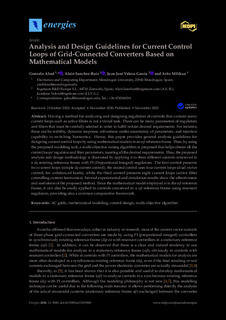Title
Analysis and Design Guidelines for Current Control Loops of Grid-Connected Converters Based on Mathematical ModelsOther institutions
Ingeteam (Spain)Version
Published version
Rights
© 2020 by the authors. Licensee MDPI, Basel, SwitzerlandAccess
Open accessPublisher’s version
https://doi.org/10.3390/en13215849Published at
Energies Vol. 13. N. 21. N. Artículo 5849, 2020Publisher
MDPI AGKeywords
AC gridsmathematical modeling
control design
multi-objective algorithm
Abstract
Having a method for analyzing and designing regulators of controls that contain many current loops such as active filters is not a trivial task. There can be many parameters of regulators and filters ... [+]
Having a method for analyzing and designing regulators of controls that contain many current loops such as active filters is not a trivial task. There can be many parameters of regulators and filters that must be carefully selected in order to fulfill certain desired requirements. For instance, these can be stability, dynamic response, robustness under uncertainty of parameters, and rejection capability to switching harmonics. Hence, this paper provides general analysis guidelines for designing current control loops by using mathematical models in an αβ reference frame. Then, by using the proposed modeling tool, a multi-objective tuning algorithm is proposed that helps obtain all the control loops’ regulator and filter parameters, meeting all the desired requirements. Thus, the proposed analysis and design methodology is illustrated by applying it to three different controls conceived in a dq rotating reference frame with PI (Proportional Integral) regulators. The first control presents two current loops (simple dq current control), the second control uses four current loops (dual vector control, for unbalanced loads), while the third control presents eight current loops (active filter controlling current harmonics). Several experimental and simulation results show the effectiveness and usefulness of the proposed method. Since the mathematical model employed is in the αβ reference frame, it can also be easily applied to controls conceived in a αβ reference frame using resonant regulators, providing also a common comparative framework. [-]
Collections
- Articles - Engineering [708]
The following license files are associated with this item:






















